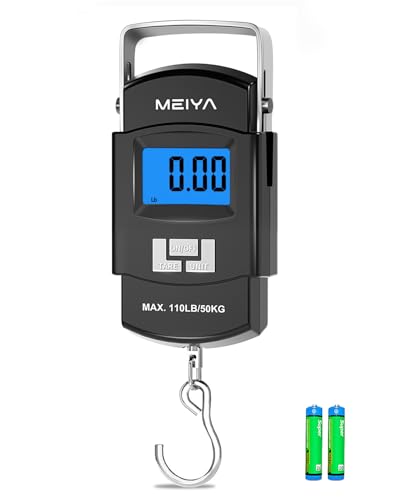In a flash of brilliance one day, I realized that I could fish after work on the days I had to go up to Gaithersburg to meet with my project team. This insight hit me when I looked at the map and saw that the Patuxent was only about 15 minutes or so from where I go in Gaithersburg. Mind whirring, calculus completed – fishing for a few hours is the perfect solution to the DC traffic dilemma. By the time I wrap things up, the traffic will have subsided at 7:30 or so – later when it is light until 8:30. Perfect solution. No issue with a kitchen pass, either as the Basswife never expects me home for dinner on the day I go north.
So, I laid my plans with eager anticipation. As usual, I wanted to print a map from TOPO to ensure I could stay oriented. As good as the Garmin maps that you can download are, they are very low resolution. When I was looking at the terrain around my office in Gaithersburg, I saw a long snaking blue line in the middle of what appeared to be a park. A quick google and the stunning facts popped to the front.
Seneca Creek State Park, a mere 5 minutes from my office, has a 16-mile stocked trout stream. Granted, it is a Put and Take, but it is still a trout stream and ( I repeat) it’s only 5 minutes from work. Putting lunchtime side trips out of my mind, I immediately concluded that my first traffic diversion would be to go here rather than to Patuxent.
The web was not very clear on where to go, so my first stop was at the park office. I chatted with the staff, and they told me that the creek is indeed fishable, that it had been recently stocked, and that I could buy a detailed topo map of the park for four bucks. Sold.
Now, where to start? It’s a tough call when you have 16 miles of choices. So, I did the logical thing: I started in the middle. I drove to the Black Rock parking area and headed downstream. There was one other truck there when I arrived and several more when I left, but I think these were probably hikers. I did not see anyone else fishing on this Monday between 5:00 and 7:00, but I did see folks out walking.
I was immediately impressed with the water. It was wide, deep, and a cool 55 degrees. There was no information on holdovers, but I doubt much survives from year to year. I’ll monitor the temperature as I return here on future occasions.
As always, I felt the need to get away from the parking lot and walked hard for 10 minutes until I could not stand it any longer. I noticed some surface activity so I put on the cricket pattern that had worked so well at Big Hunting Creek and started to work. I got a few flashes and splashes on it, but did not land anything. Switched to a dry fly – a gnat – no action. Switched to nymphs and spent 20 minutes screwed up in trees, bushes and tangled line. Got to learn to move gently and with less eagerness. This fly stuff gets all confused with a twitch or two of the rod at the wrong time..
I continued to fish my way downstream. The water remained deep while offering a number of shallow areas where it was easy to cross the stream to pursue a different angle of attack.
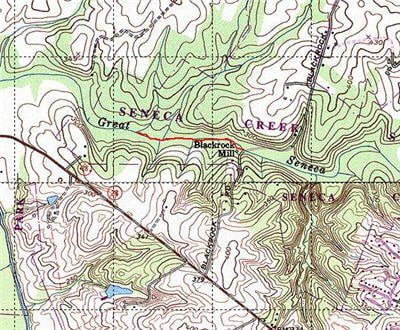
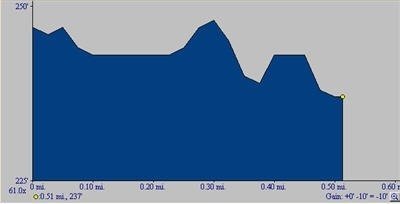
All in all, a good evening’s diversion prior to heading into the mixing bowl of DC traffic. I did not catch any fish, but this was more of a recon anyway. This week, I’ll slay ’em.
I don’t have a good feel for pressure since this was on a weekday and just assume this water is hammered. When I was talking with the park staff, they mentioned that they have a large turnout whenever stocking is announced.
The trout that flashed my cricket were decent size – so why rate this as RED given that I will spend any number of days this summer fishing here? It’s just not trouty enough. My opinion may change as I get to know more of the water and get a sense of the fish here, but first impressions are that you will probably find a better day on the weekend elsewhere.
One final point – bring your chest waders. The water is deep enough in enough places to merit a little extra height.
Getting There: The directions on the website are good.
“The park is located in Montgomery County. From Washington, D.C, Virginia and points south, take I-270 north towards Frederick, Maryland. Take Exit 10, Clopper Road (Route 117). Turn right at the light at the bottom of the ramp. The park is approximately 2 miles on the left.
From points north, take I-270 south towards Washington, D.C., take Exit 11 (MD Route 124 west). Turn right at the light at the bottom of the ramp. At the second light, turn right onto Clopper Road (Route 117). The park is approximately 1.5 miles on the left.”
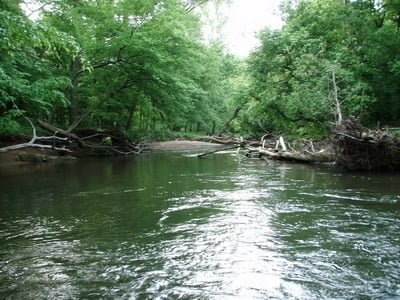
Note how wide the river is. I brought my 4wt on this first trip expecting something smaller. From here on out, it’s the 6wt.
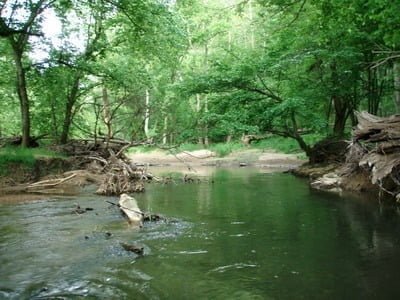
There is plenty of structure on this creek. Sadly, there is also plenty above the creek and, if you are a new fly guy like myself, you do need to be a bit careful on your casting.
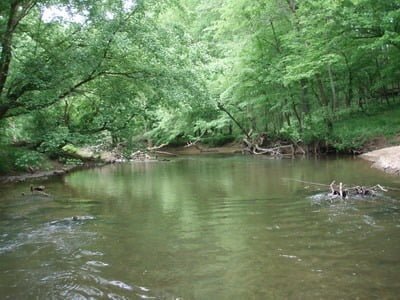
Typical area of riffles where it is easy to cross.

Some sections are deep to the point of not showing much current. You can float a canoe thru much of this, but I’m not sure why you would want to. Easier to fish it from the shore and wading.
Unless stated otherwise, this article was authored by Steve Moore


